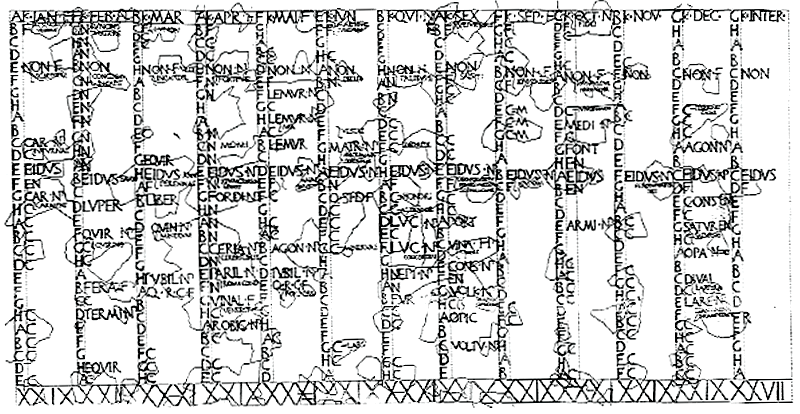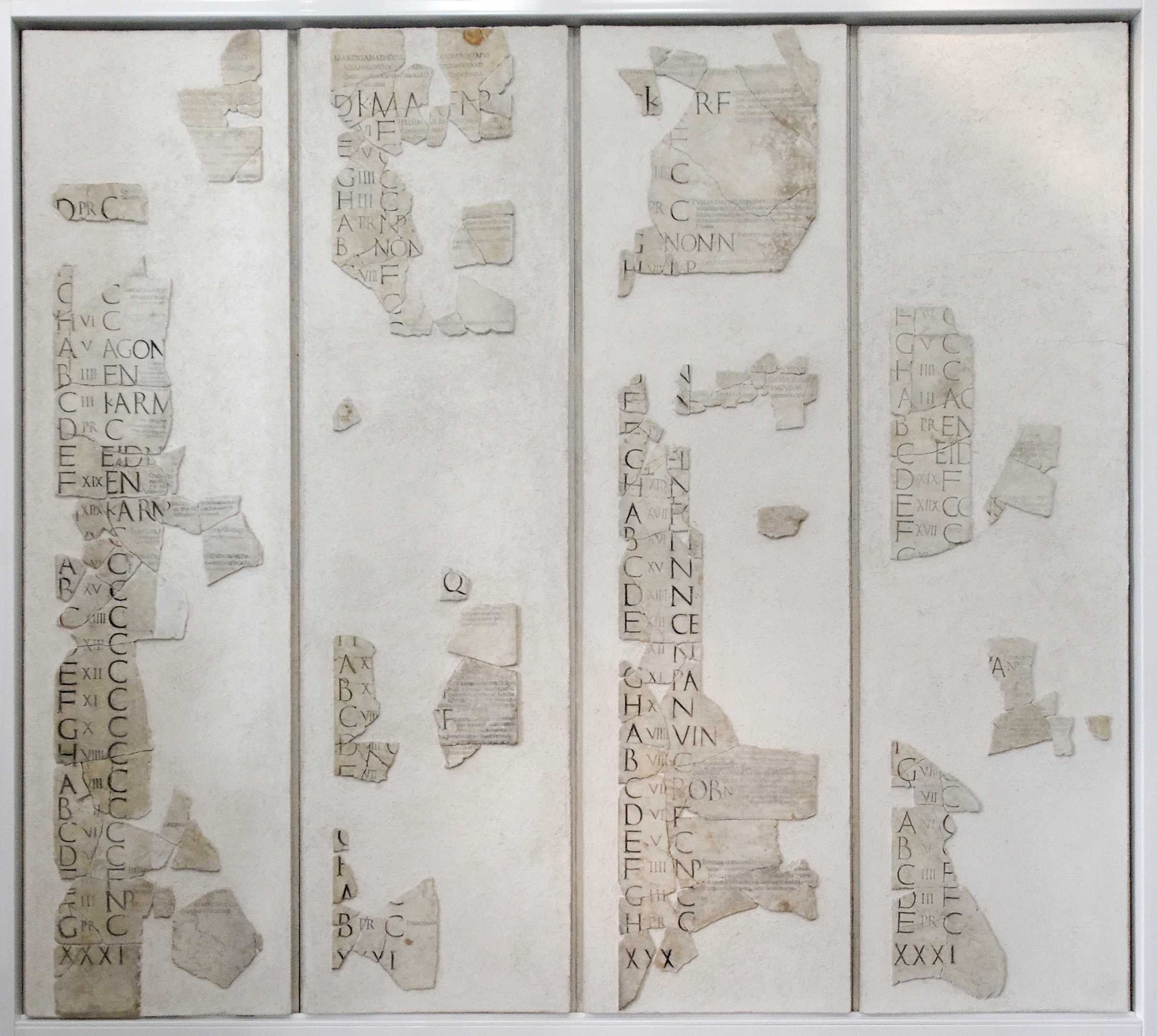|
December (Roman Month)
December (from Latin ''decem'', "ten") or ''mensis December'' was originally the tenth month of the Roman calendar, following November (''novem'', "nine") and preceding Ianuarius. It had 29 days. When the calendar was reformed to create a 12-month year starting in Ianuarius, December became the twelfth month, but retained its name, as did the other numbered months from Quintilis (July) to December. Its length was increased to 31 days under the Julian calendar reform. Dates The Romans did not number days of a month sequentially from the first day through the last. Instead, they counted back from the three fixed points of the month: the Nones (5th or 7th), the Ides (13th or 15th), and the Kalends (1st) of the following month. The Nones of December was the 5th, and the Ides the 13th. The last day of December was the ''pridie Kalendas Ianuarias,'' "day before the Januarian Kalends". Roman counting was inclusive; December 9 was ''ante diem V Idūs Decembrīs'', "the 5th day before the ... [...More Info...] [...Related Items...] OR: [Wikipedia] [Google] [Baidu] |
Roman Calendar
The Roman calendar was the calendar used by the Roman Kingdom and Roman Republic. The term often includes the Julian calendar established by the reforms of the Roman dictator, dictator Julius Caesar and Roman emperor, emperor Augustus in the late 1stcenturyBC and sometimes includes any system dated by inclusive counting towards months' kalends, nones (calendar), nones, and ides (calendar), ides in the Roman manner. The term usually excludes the Alexandrian calendar of Roman Egypt, which continued the unique months of that land's Egyptian calendar, former calendar; the Byzantine calendar of the Byzantine Empire, later Roman Empire, which usually dated the Roman months in the simple count of the ancient Greek calendars; and the Gregorian calendar, which refined the Julian system to bring it into still closer alignment with the tropical year. Roman dates were counted inclusively forward to the next of three principal days: the first of the month (the kalends), a day shortly befor ... [...More Info...] [...Related Items...] OR: [Wikipedia] [Google] [Baidu] |
November (Roman Month)
November (from Latin ''novem'', "nine") or ''mensis November'' was originally the ninth of ten months on the Roman calendar, following October (''octo'', "eight") and preceding December (''decem'', "ten"). It had 29 days. In the reform that resulted in a 12-month year, November became the eleventh month, but retained its name, as did the other months from September through December. A day was added to November during the Julian calendar reform in the mid-40s BC. The outstanding event during November was the Plebeian Games from the 4th through the 17th. The month had few other festivals. It was under the guardianship ''( tutela)'' of Diana. In the agricultural year The ancient farmers' almanacs ''(menologia rustica)'' instruct farmers to sow wheat and barley, and to attend to ''scribatio'', trenching around trees. Iconography of the month When the months are represented by agricultural activities, a man with a four-prong drag hoe ''(rastrum quadridens)'' can sometimes appear as N ... [...More Info...] [...Related Items...] OR: [Wikipedia] [Google] [Baidu] |
Ianuarius
''Ianuarius'', fully ''Mensis Ianuarius'' ("month of Janus"), was the first month of the ancient Roman calendar, from which the Julian and Gregorian month of January derived. It was followed by '' Februarius'' (" February"). In the calendars of the Roman Republic, ''Ianuarius'' had 29 days. Two days were added when the calendar was reformed under Julius Caesar in 45 BCE. In the oldest Roman calendar, which the Romans believed to have been instituted by their legendary founder Romulus, the first month was '' Martius'' ("month of Mars", March), and the calendar year had only ten months. ''Ianuarius'' and ''Februarius'' were supposed to have been added by Numa Pompilius, the second king of Rome, originally at the end of the year. It is unclear when the Romans reset the course of the year so that January and February came first. ''Ianuarius'' is conventionally thought to have taken its name from Janus, the dual-faced god of beginnings, openings, passages, gates and doorways, ... [...More Info...] [...Related Items...] OR: [Wikipedia] [Google] [Baidu] |
Julian Calendar
The Julian calendar, proposed by Roman consul Julius Caesar in 46 BC, was a reform of the Roman calendar. It took effect on , by edict. It was designed with the aid of Greek mathematicians and astronomers such as Sosigenes of Alexandria. The calendar became the predominant calendar in the Roman Empire and subsequently most of the Western world for more than 1,600 years until 1582, when Pope Gregory XIII promulgated a minor modification to reduce the average length of the year from 365.25 days to 365.2425 days and thus corrected the Julian calendar's drift against the solar year. Worldwide adoption of this revised calendar, which became known as the Gregorian calendar, took place over the subsequent centuries, first in Catholic countries and subsequently in Protestant countries of the Western Christian world. The Julian calendar is still used in parts of the Eastern Orthodox Church and in parts of Oriental Orthodoxy as well as by the Berbers. The Julian calenda ... [...More Info...] [...Related Items...] OR: [Wikipedia] [Google] [Baidu] |
Nones (calendar)
The Roman calendar was the calendar used by the Roman Kingdom and Roman Republic. The term often includes the Julian calendar established by the reforms of the dictator Julius Caesar and emperor Augustus in the late 1stcenturyBC and sometimes includes any system dated by inclusive counting towards months' kalends, nones, and ides in the Roman manner. The term usually excludes the Alexandrian calendar of Roman Egypt, which continued the unique months of that land's former calendar; the Byzantine calendar of the later Roman Empire, which usually dated the Roman months in the simple count of the ancient Greek calendars; and the Gregorian calendar, which refined the Julian system to bring it into still closer alignment with the tropical year. Roman dates were counted inclusively forward to the next of three principal days: the first of the month (the kalends), a day shortly before the middle of the month (the ides), and eight days—nine, counting inclusively—before this (the ... [...More Info...] [...Related Items...] OR: [Wikipedia] [Google] [Baidu] |
Ides (calendar)
The Roman calendar was the calendar used by the Roman Kingdom and Roman Republic. The term often includes the Julian calendar established by the reforms of the dictator Julius Caesar and emperor Augustus in the late 1stcenturyBC and sometimes includes any system dated by inclusive counting towards months' kalends, nones, and ides in the Roman manner. The term usually excludes the Alexandrian calendar of Roman Egypt, which continued the unique months of that land's former calendar; the Byzantine calendar of the later Roman Empire, which usually dated the Roman months in the simple count of the ancient Greek calendars; and the Gregorian calendar, which refined the Julian system to bring it into still closer alignment with the tropical year. Roman dates were counted inclusively forward to the next of three principal days: the first of the month (the kalends), a day shortly before the middle of the month (the ides), and eight days—nine, counting inclusively—before this (the ... [...More Info...] [...Related Items...] OR: [Wikipedia] [Google] [Baidu] |
Kalends
The calends or kalends ( la, kalendae) is the first day of every month in the Roman calendar. The English word "calendar" is derived from this word. Use The Romans called the first day of every month the ''calends'', signifying the start of a new lunar phase. On this day, the pontiffs would announce the number of days until the next month at the Curia Calabra; in addition, debtors had to pay off their debts on this day. These debts were inscribed in the ''kalendaria'', effectively an accounting book. Modern calendars count the number of days ''after'' the first of each month; by contrast, the Roman calendar counted the number of days ''until'' certain upcoming dates (such as the calends, the nones or the ides). The day before the calends was called ''pridie kalendas'', but the day before that was counted as the "third day", as Romans used inclusive counting. To calculate the day of the calends of the upcoming month, counting the number of days remaining in the current month is ... [...More Info...] [...Related Items...] OR: [Wikipedia] [Google] [Baidu] |
Grammatical Gender
In linguistics, grammatical gender system is a specific form of noun class system, where nouns are assigned with gender categories that are often not related to their real-world qualities. In languages with grammatical gender, most or all nouns inherently carry one value of the grammatical category called ''gender''; the values present in a given language (of which there are usually two or three) are called the ''genders'' of that language. Whereas some authors use the term "grammatical gender" as a synonym of "noun class", others use different definitions for each; many authors prefer "noun classes" when none of the inflections in a language relate to sex. Gender systems are used in approximately one half of the world's languages. According to one definition: "Genders are classes of nouns reflected in the behaviour of associated words." Overview Languages with grammatical gender usually have two to four different genders, but some are attested with up to 20. #Gender contras ... [...More Info...] [...Related Items...] OR: [Wikipedia] [Google] [Baidu] |
Inclusive Counting
Counting is the process of determining the number of elements of a finite set of objects, i.e., determining the size of a set. The traditional way of counting consists of continually increasing a (mental or spoken) counter by a unit for every element of the set, in some order, while marking (or displacing) those elements to avoid visiting the same element more than once, until no unmarked elements are left; if the counter was set to one after the first object, the value after visiting the final object gives the desired number of elements. The related term ''enumeration'' refers to uniquely identifying the elements of a finite (combinatorial) set or infinite set by assigning a number to each element. Counting sometimes involves numbers other than one; for example, when counting money, counting out change, "counting by twos" (2, 4, 6, 8, 10, 12, ...), or "counting by fives" (5, 10, 15, 20, 25, ...). There is archaeological evidence suggesting that humans have been countin ... [...More Info...] [...Related Items...] OR: [Wikipedia] [Google] [Baidu] |
Roman Republic
The Roman Republic ( la, Res publica Romana ) was a form of government of Rome and the era of the classical Roman civilization when it was run through public representation of the Roman people. Beginning with the overthrow of the Roman Kingdom (traditionally dated to 509 BC) and ending in 27 BC with the establishment of the Roman Empire, Rome's control rapidly expanded during this period—from the city's immediate surroundings to hegemony over the entire Mediterranean world. Roman society under the Republic was primarily a cultural mix of Latin and Etruscan societies, as well as of Sabine, Oscan, and Greek cultural elements, which is especially visible in the Roman Pantheon. Its political organization developed, at around the same time as direct democracy in Ancient Greece, with collective and annual magistracies, overseen by a senate. The top magistrates were the two consuls, who had an extensive range of executive, legislative, judicial, military, and religious powers ... [...More Info...] [...Related Items...] OR: [Wikipedia] [Google] [Baidu] |
Principate
The Principate is the name sometimes given to the first period of the Roman Empire from the beginning of the reign of Augustus in 27 BC to the end of the Crisis of the Third Century in AD 284, after which it evolved into the so-called Dominate. The Principate is characterised by the reign of a single emperor (''princeps'') and an effort on the part of the early emperors, at least, to preserve the illusion of the formal continuance, in some aspects, of the Roman Republic. Etymology and anticipations *'Principate' is etymologically derived from the Latin word ''princeps'', meaning ''chief'' or ''first'', and therefore represents the political regime dominated by such a political leader, whether or not he is formally head of state or head of government. This reflects the principate emperors' assertion that they were merely "first among equals" among the citizens of Rome. *Under the Republic, the ''princeps senatus'', traditionally the oldest or most honoured member of the Senate, ... [...More Info...] [...Related Items...] OR: [Wikipedia] [Google] [Baidu] |
Marcus Aurelius
Marcus Aurelius Antoninus (Latin: áːɾkus̠ auɾέːli.us̠ antɔ́ːni.us̠ English: ; 26 April 121 – 17 March 180) was Roman emperor from 161 to 180 AD and a Stoic philosopher. He was the last of the rulers known as the Five Good Emperors (a term coined some 13 centuries later by Niccolò Machiavelli), and the last emperor of the Pax Romana, an age of relative peace and stability for the Roman Empire lasting from 27 BC to 180 AD. He served as Roman consul in 140, 145, and 161. Marcus Aurelius was born during the reign of Hadrian to the emperor's nephew, the praetor Marcus Annius Verus, and the heiress Domitia Calvilla. His father died when he was three, and his mother and grandfather raised him. After Hadrian's adoptive son, Aelius Caesar, died in 138, the emperor adopted Marcus's uncle Antoninus Pius as his new heir. In turn, Antoninus adopted Marcus and Lucius, the son of Aelius. Hadrian died that year, and Antoninus became emperor. Now heir to the throne, ... [...More Info...] [...Related Items...] OR: [Wikipedia] [Google] [Baidu] |


_(cropped).jpg)





